Cross-Curricular Learning at Imperial War Museum: KS1 Report
VerifiedAdded on 2020/05/16
|19
|3988
|50
Report
AI Summary
This report details a planned field trip to the Imperial War Museum in London for Key Stage 1 (KS1) pupils, focusing on cross-curricular learning. The assignment explores how the museum visit can enhance learning in English, history, geography, and art and design, using the World War II theme. It includes pre-visit, on-site, and post-visit activities designed to engage students and foster a deeper understanding of the subjects. The report discusses critical aspects of creativity in education, the National Curriculum framework, and the benefits of thematic and cross-curricular approaches. Risk assessments, recommended resources, and references are also provided, offering a comprehensive guide for educators looking to integrate museum visits into their curriculum to motivate students and improve their learning experiences.
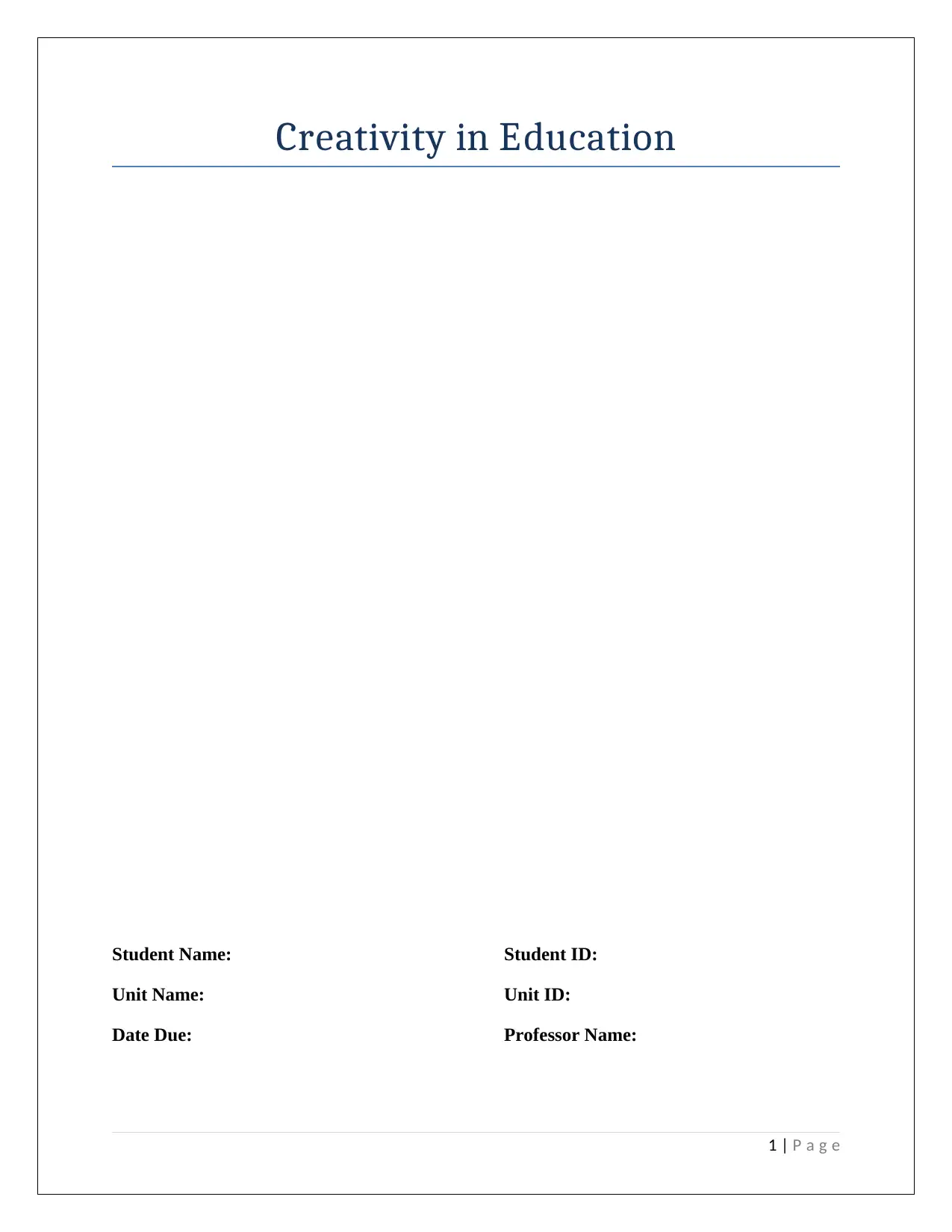
Creativity in Education
Student Name: Student ID:
Unit Name: Unit ID:
Date Due: Professor Name:
1 | P a g e
Student Name: Student ID:
Unit Name: Unit ID:
Date Due: Professor Name:
1 | P a g e
Paraphrase This Document
Need a fresh take? Get an instant paraphrase of this document with our AI Paraphraser

Executive Summary
Field trip to museum provides pupils especially of KS1 with motivational values to pursue their
studies. The scope of this study will ways in which core subject English was developed in a cross
curriculum approach with history, geography and art & Design. A short preparation activity with
follow-up activities providing learning opportunities are also discussed.
2 | P a g e
Field trip to museum provides pupils especially of KS1 with motivational values to pursue their
studies. The scope of this study will ways in which core subject English was developed in a cross
curriculum approach with history, geography and art & Design. A short preparation activity with
follow-up activities providing learning opportunities are also discussed.
2 | P a g e
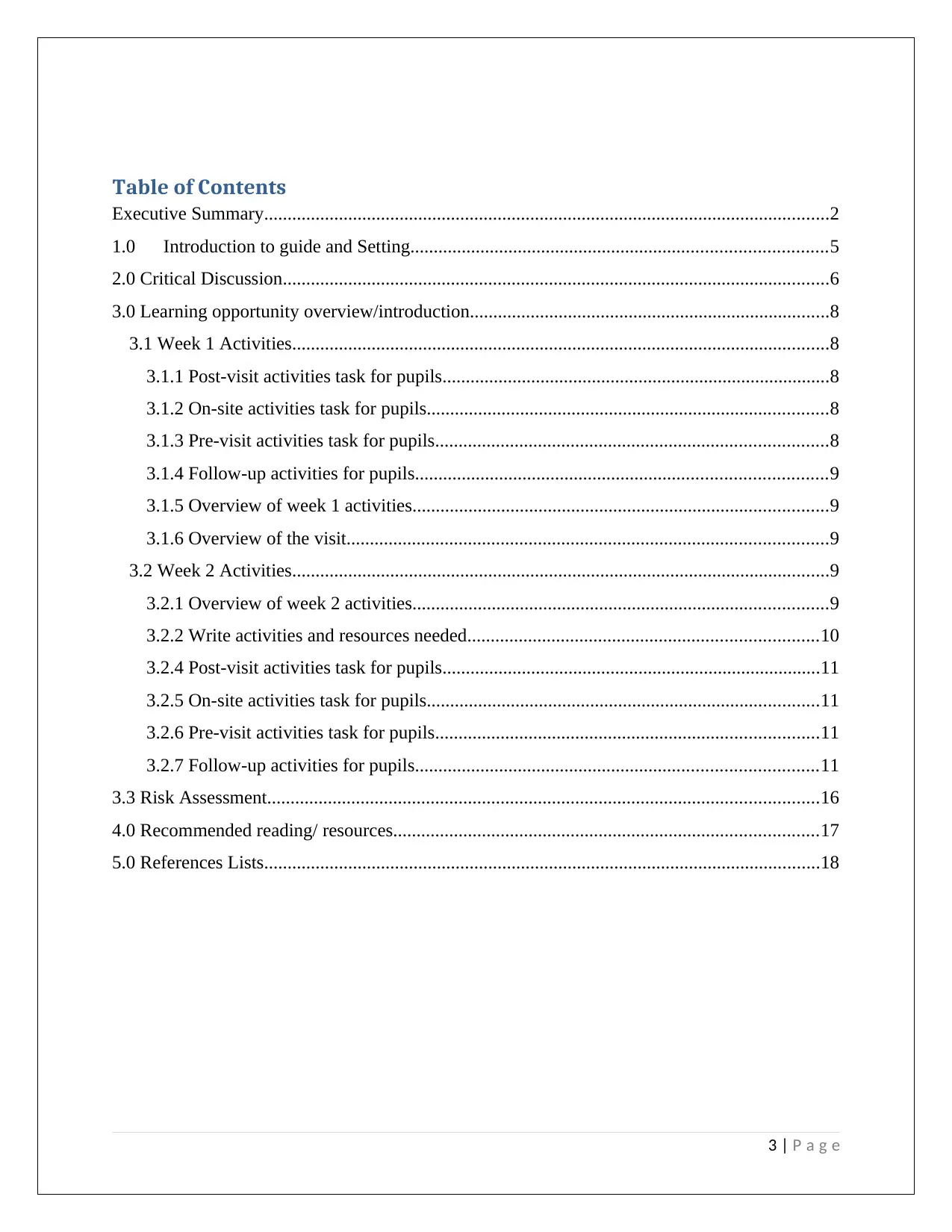
Table of Contents
Executive Summary.........................................................................................................................2
1.0 Introduction to guide and Setting.........................................................................................5
2.0 Critical Discussion.....................................................................................................................6
3.0 Learning opportunity overview/introduction.............................................................................8
3.1 Week 1 Activities...................................................................................................................8
3.1.1 Post-visit activities task for pupils...................................................................................8
3.1.2 On-site activities task for pupils......................................................................................8
3.1.3 Pre-visit activities task for pupils....................................................................................8
3.1.4 Follow-up activities for pupils........................................................................................9
3.1.5 Overview of week 1 activities.........................................................................................9
3.1.6 Overview of the visit.......................................................................................................9
3.2 Week 2 Activities...................................................................................................................9
3.2.1 Overview of week 2 activities.........................................................................................9
3.2.2 Write activities and resources needed...........................................................................10
3.2.4 Post-visit activities task for pupils.................................................................................11
3.2.5 On-site activities task for pupils....................................................................................11
3.2.6 Pre-visit activities task for pupils..................................................................................11
3.2.7 Follow-up activities for pupils......................................................................................11
3.3 Risk Assessment......................................................................................................................16
4.0 Recommended reading/ resources...........................................................................................17
5.0 References Lists.......................................................................................................................18
3 | P a g e
Executive Summary.........................................................................................................................2
1.0 Introduction to guide and Setting.........................................................................................5
2.0 Critical Discussion.....................................................................................................................6
3.0 Learning opportunity overview/introduction.............................................................................8
3.1 Week 1 Activities...................................................................................................................8
3.1.1 Post-visit activities task for pupils...................................................................................8
3.1.2 On-site activities task for pupils......................................................................................8
3.1.3 Pre-visit activities task for pupils....................................................................................8
3.1.4 Follow-up activities for pupils........................................................................................9
3.1.5 Overview of week 1 activities.........................................................................................9
3.1.6 Overview of the visit.......................................................................................................9
3.2 Week 2 Activities...................................................................................................................9
3.2.1 Overview of week 2 activities.........................................................................................9
3.2.2 Write activities and resources needed...........................................................................10
3.2.4 Post-visit activities task for pupils.................................................................................11
3.2.5 On-site activities task for pupils....................................................................................11
3.2.6 Pre-visit activities task for pupils..................................................................................11
3.2.7 Follow-up activities for pupils......................................................................................11
3.3 Risk Assessment......................................................................................................................16
4.0 Recommended reading/ resources...........................................................................................17
5.0 References Lists.......................................................................................................................18
3 | P a g e
⊘ This is a preview!⊘
Do you want full access?
Subscribe today to unlock all pages.

Trusted by 1+ million students worldwide
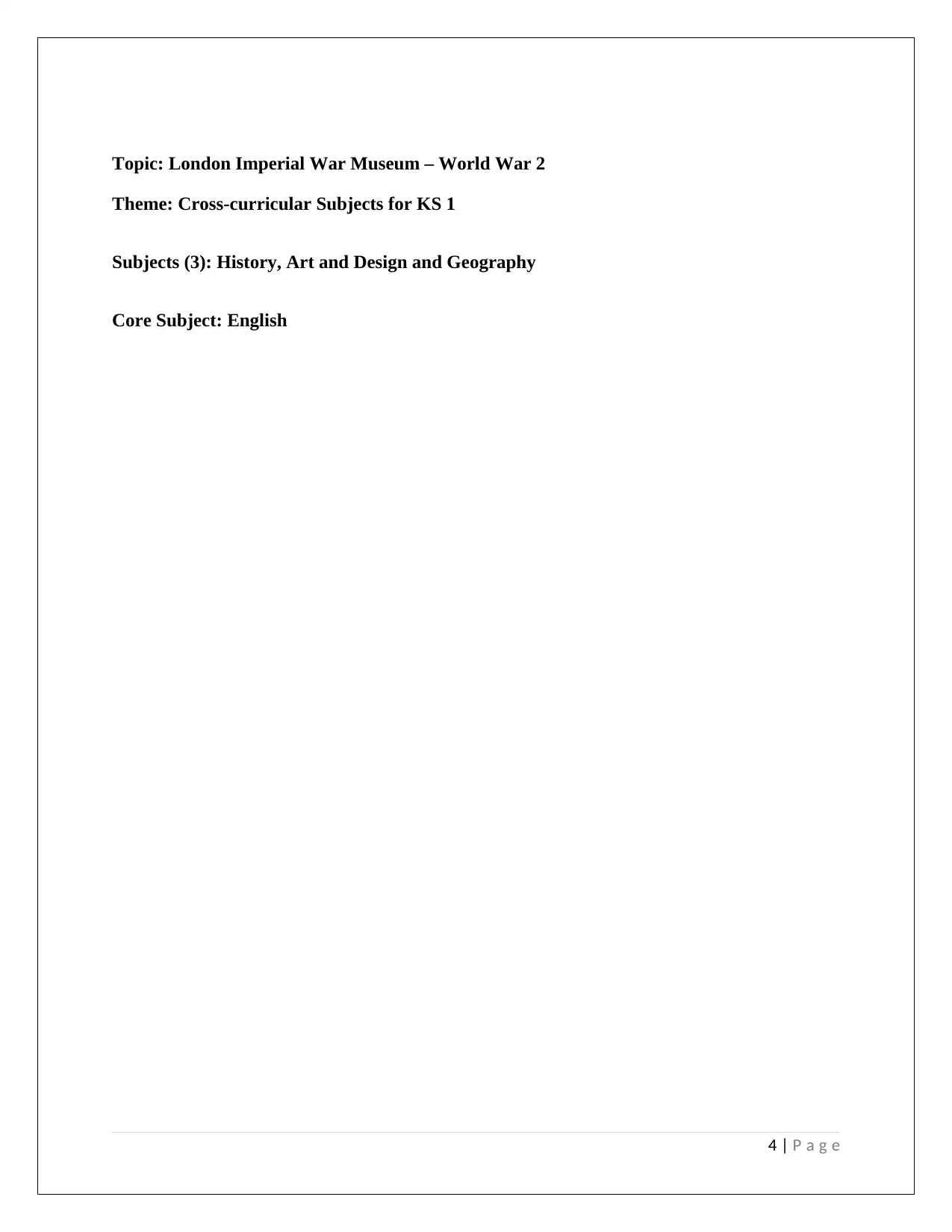
Topic: London Imperial War Museum – World War 2
Theme: Cross-curricular Subjects for KS 1
Subjects (3): History, Art and Design and Geography
Core Subject: English
4 | P a g e
Theme: Cross-curricular Subjects for KS 1
Subjects (3): History, Art and Design and Geography
Core Subject: English
4 | P a g e
Paraphrase This Document
Need a fresh take? Get an instant paraphrase of this document with our AI Paraphraser
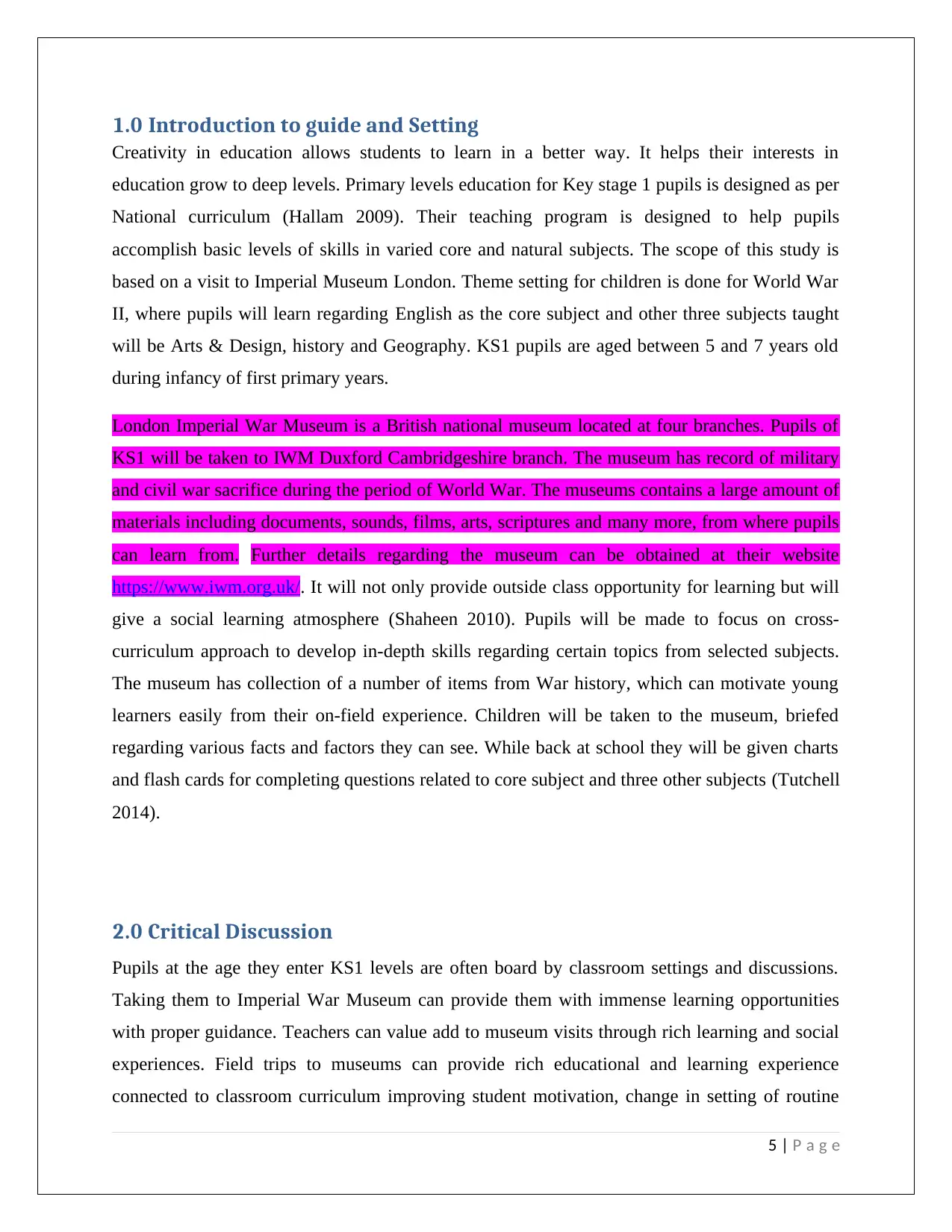
1.0 Introduction to guide and Setting
Creativity in education allows students to learn in a better way. It helps their interests in
education grow to deep levels. Primary levels education for Key stage 1 pupils is designed as per
National curriculum (Hallam 2009). Their teaching program is designed to help pupils
accomplish basic levels of skills in varied core and natural subjects. The scope of this study is
based on a visit to Imperial Museum London. Theme setting for children is done for World War
II, where pupils will learn regarding English as the core subject and other three subjects taught
will be Arts & Design, history and Geography. KS1 pupils are aged between 5 and 7 years old
during infancy of first primary years.
London Imperial War Museum is a British national museum located at four branches. Pupils of
KS1 will be taken to IWM Duxford Cambridgeshire branch. The museum has record of military
and civil war sacrifice during the period of World War. The museums contains a large amount of
materials including documents, sounds, films, arts, scriptures and many more, from where pupils
can learn from. Further details regarding the museum can be obtained at their website
https://www.iwm.org.uk/. It will not only provide outside class opportunity for learning but will
give a social learning atmosphere (Shaheen 2010). Pupils will be made to focus on cross-
curriculum approach to develop in-depth skills regarding certain topics from selected subjects.
The museum has collection of a number of items from War history, which can motivate young
learners easily from their on-field experience. Children will be taken to the museum, briefed
regarding various facts and factors they can see. While back at school they will be given charts
and flash cards for completing questions related to core subject and three other subjects (Tutchell
2014).
2.0 Critical Discussion
Pupils at the age they enter KS1 levels are often board by classroom settings and discussions.
Taking them to Imperial War Museum can provide them with immense learning opportunities
with proper guidance. Teachers can value add to museum visits through rich learning and social
experiences. Field trips to museums can provide rich educational and learning experience
connected to classroom curriculum improving student motivation, change in setting of routine
5 | P a g e
Creativity in education allows students to learn in a better way. It helps their interests in
education grow to deep levels. Primary levels education for Key stage 1 pupils is designed as per
National curriculum (Hallam 2009). Their teaching program is designed to help pupils
accomplish basic levels of skills in varied core and natural subjects. The scope of this study is
based on a visit to Imperial Museum London. Theme setting for children is done for World War
II, where pupils will learn regarding English as the core subject and other three subjects taught
will be Arts & Design, history and Geography. KS1 pupils are aged between 5 and 7 years old
during infancy of first primary years.
London Imperial War Museum is a British national museum located at four branches. Pupils of
KS1 will be taken to IWM Duxford Cambridgeshire branch. The museum has record of military
and civil war sacrifice during the period of World War. The museums contains a large amount of
materials including documents, sounds, films, arts, scriptures and many more, from where pupils
can learn from. Further details regarding the museum can be obtained at their website
https://www.iwm.org.uk/. It will not only provide outside class opportunity for learning but will
give a social learning atmosphere (Shaheen 2010). Pupils will be made to focus on cross-
curriculum approach to develop in-depth skills regarding certain topics from selected subjects.
The museum has collection of a number of items from War history, which can motivate young
learners easily from their on-field experience. Children will be taken to the museum, briefed
regarding various facts and factors they can see. While back at school they will be given charts
and flash cards for completing questions related to core subject and three other subjects (Tutchell
2014).
2.0 Critical Discussion
Pupils at the age they enter KS1 levels are often board by classroom settings and discussions.
Taking them to Imperial War Museum can provide them with immense learning opportunities
with proper guidance. Teachers can value add to museum visits through rich learning and social
experiences. Field trips to museums can provide rich educational and learning experience
connected to classroom curriculum improving student motivation, change in setting of routine
5 | P a g e

providing student enjoyment or providing new experiences (Compton 2011). Students of KS1
after museum visits is bound to be more enthusiast towards learning History, Geography or Art
& Design. With follow-up activities more positive activities can be expressed from pupils rather
than in classroom settings. Field trips can provide long-sustaining cognitive learning impacts in
all subjects. For this filed trip English vocabulary has been focused on. In the domain of History,
all World War impacts that have changed London has been analysed. In Geography knowledge
of various places where the War took place will be discussed (Dobbins 2009). In Art & Design
pupils will be expected to draw art forms that they visualize from the museum.
National Curriculum in England is a framework for key stages 1 to 4 that defines full program of
study along with attainment targets (Lytton 2012). It is issued by the law and forms statutory,
which has to be followed by schools. All local-authority maintained schools has to follow these
programs of study. It was introduced in the year September 2014, with English and math being
included from September 2016.
Creativity in primary level subjects encourage pupils to learn through their subjects. Raise
questions accordingly and motivate them to take interest to carry activities. Creativity can be
done by various efforts by teachers to converge practical field into subjects to create interests
amongst students.
Thematic approach in learning to the curriculum is an innovative method of education and
developing pupils with complex needs (Craft 2014). The principle focus of this approach is
unique and requires to be individualized such that they are capable of meeting challenges of
twenty first century. The benefit from this approach includes catering to individual capabilities of
pupils that are unique in nature. Creation of an individual learning path by a multi-disciplinary
approach in an integrated method for fulfilling education needs. Thematic approach helps pupils
learn in 5 distinct areas of learning communication as cognition, independence, physical &
motor, creative & expressive and emotional literacy. Limitations of thematic approach includes
dilution of focus in learning. It also requires immense amounts of time, which often is
unavailable with teachers.
Cross-curriculum skills of communication using of English can be developed by means of which
young people access knowledge. Teachers are responsible for development of these skills by
6 | P a g e
after museum visits is bound to be more enthusiast towards learning History, Geography or Art
& Design. With follow-up activities more positive activities can be expressed from pupils rather
than in classroom settings. Field trips can provide long-sustaining cognitive learning impacts in
all subjects. For this filed trip English vocabulary has been focused on. In the domain of History,
all World War impacts that have changed London has been analysed. In Geography knowledge
of various places where the War took place will be discussed (Dobbins 2009). In Art & Design
pupils will be expected to draw art forms that they visualize from the museum.
National Curriculum in England is a framework for key stages 1 to 4 that defines full program of
study along with attainment targets (Lytton 2012). It is issued by the law and forms statutory,
which has to be followed by schools. All local-authority maintained schools has to follow these
programs of study. It was introduced in the year September 2014, with English and math being
included from September 2016.
Creativity in primary level subjects encourage pupils to learn through their subjects. Raise
questions accordingly and motivate them to take interest to carry activities. Creativity can be
done by various efforts by teachers to converge practical field into subjects to create interests
amongst students.
Thematic approach in learning to the curriculum is an innovative method of education and
developing pupils with complex needs (Craft 2014). The principle focus of this approach is
unique and requires to be individualized such that they are capable of meeting challenges of
twenty first century. The benefit from this approach includes catering to individual capabilities of
pupils that are unique in nature. Creation of an individual learning path by a multi-disciplinary
approach in an integrated method for fulfilling education needs. Thematic approach helps pupils
learn in 5 distinct areas of learning communication as cognition, independence, physical &
motor, creative & expressive and emotional literacy. Limitations of thematic approach includes
dilution of focus in learning. It also requires immense amounts of time, which often is
unavailable with teachers.
Cross-curriculum skills of communication using of English can be developed by means of which
young people access knowledge. Teachers are responsible for development of these skills by
6 | P a g e
⊘ This is a preview!⊘
Do you want full access?
Subscribe today to unlock all pages.

Trusted by 1+ million students worldwide

emphasis on transferring and applying of these skills throughout school curriculum (Runco
2008). Schools will then report annually regarding each pupil’s progress with Levels of
Progression. Communication in English will be developed using cross-curriculum approach by
means of learning new words. Communications skills in History can be developed using cross-
curriculum skills of various incidents happening at various times in the past. Relative to
geography, it will take place in the form of communicating various names of places. In Art &
Design they will be typically communicated through various drawings and forms.
Teacher’s guide in KS1 levels includes administering the level as well as prepare according to
test administration guidance (TAG). Teacher’s needs to plan for tests by finalizing on key dates,
receive test materials also sample tests, administration, moderating, assessing and reporting tests
as per framework provided.
Early learning amongst children has discussed various opportunities for children to learn in
museums. Museums can provide large number of learning materials and source from where
children can easily pick up by visualization of facts and hearing regarding certain occurrences
(Csikszentmihalyi 2014). These exposures cannot be provided in enclosed classroom
environment. Teachers can make use of various methods or equipment to enhance such learning
experiences that are given to children. It can help provoke imagination amongst children of the
subject matter. Spending quality time at the museum can be a rich experience of learning
regarding the unknown world. Children cannot be exposed regarding the impact of world War,
which is the present theme in a better way compared to when they directly experience it
themselves by facts and figures.
7 | P a g e
2008). Schools will then report annually regarding each pupil’s progress with Levels of
Progression. Communication in English will be developed using cross-curriculum approach by
means of learning new words. Communications skills in History can be developed using cross-
curriculum skills of various incidents happening at various times in the past. Relative to
geography, it will take place in the form of communicating various names of places. In Art &
Design they will be typically communicated through various drawings and forms.
Teacher’s guide in KS1 levels includes administering the level as well as prepare according to
test administration guidance (TAG). Teacher’s needs to plan for tests by finalizing on key dates,
receive test materials also sample tests, administration, moderating, assessing and reporting tests
as per framework provided.
Early learning amongst children has discussed various opportunities for children to learn in
museums. Museums can provide large number of learning materials and source from where
children can easily pick up by visualization of facts and hearing regarding certain occurrences
(Csikszentmihalyi 2014). These exposures cannot be provided in enclosed classroom
environment. Teachers can make use of various methods or equipment to enhance such learning
experiences that are given to children. It can help provoke imagination amongst children of the
subject matter. Spending quality time at the museum can be a rich experience of learning
regarding the unknown world. Children cannot be exposed regarding the impact of world War,
which is the present theme in a better way compared to when they directly experience it
themselves by facts and figures.
7 | P a g e
Paraphrase This Document
Need a fresh take? Get an instant paraphrase of this document with our AI Paraphraser
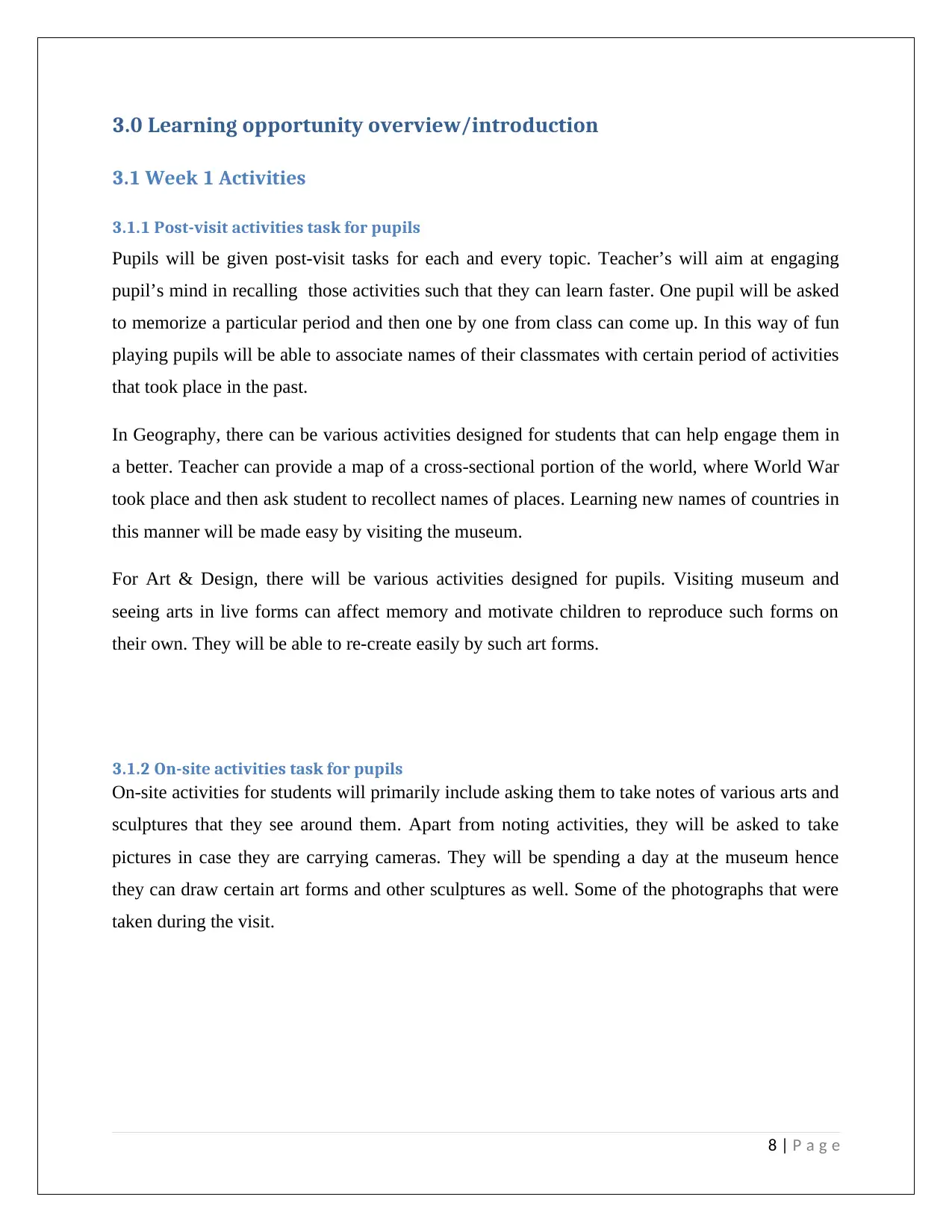
3.0 Learning opportunity overview/introduction
3.1 Week 1 Activities
3.1.1 Post-visit activities task for pupils
Pupils will be given post-visit tasks for each and every topic. Teacher’s will aim at engaging
pupil’s mind in recalling those activities such that they can learn faster. One pupil will be asked
to memorize a particular period and then one by one from class can come up. In this way of fun
playing pupils will be able to associate names of their classmates with certain period of activities
that took place in the past.
In Geography, there can be various activities designed for students that can help engage them in
a better. Teacher can provide a map of a cross-sectional portion of the world, where World War
took place and then ask student to recollect names of places. Learning new names of countries in
this manner will be made easy by visiting the museum.
For Art & Design, there will be various activities designed for pupils. Visiting museum and
seeing arts in live forms can affect memory and motivate children to reproduce such forms on
their own. They will be able to re-create easily by such art forms.
3.1.2 On-site activities task for pupils
On-site activities for students will primarily include asking them to take notes of various arts and
sculptures that they see around them. Apart from noting activities, they will be asked to take
pictures in case they are carrying cameras. They will be spending a day at the museum hence
they can draw certain art forms and other sculptures as well. Some of the photographs that were
taken during the visit.
8 | P a g e
3.1 Week 1 Activities
3.1.1 Post-visit activities task for pupils
Pupils will be given post-visit tasks for each and every topic. Teacher’s will aim at engaging
pupil’s mind in recalling those activities such that they can learn faster. One pupil will be asked
to memorize a particular period and then one by one from class can come up. In this way of fun
playing pupils will be able to associate names of their classmates with certain period of activities
that took place in the past.
In Geography, there can be various activities designed for students that can help engage them in
a better. Teacher can provide a map of a cross-sectional portion of the world, where World War
took place and then ask student to recollect names of places. Learning new names of countries in
this manner will be made easy by visiting the museum.
For Art & Design, there will be various activities designed for pupils. Visiting museum and
seeing arts in live forms can affect memory and motivate children to reproduce such forms on
their own. They will be able to re-create easily by such art forms.
3.1.2 On-site activities task for pupils
On-site activities for students will primarily include asking them to take notes of various arts and
sculptures that they see around them. Apart from noting activities, they will be asked to take
pictures in case they are carrying cameras. They will be spending a day at the museum hence
they can draw certain art forms and other sculptures as well. Some of the photographs that were
taken during the visit.
8 | P a g e
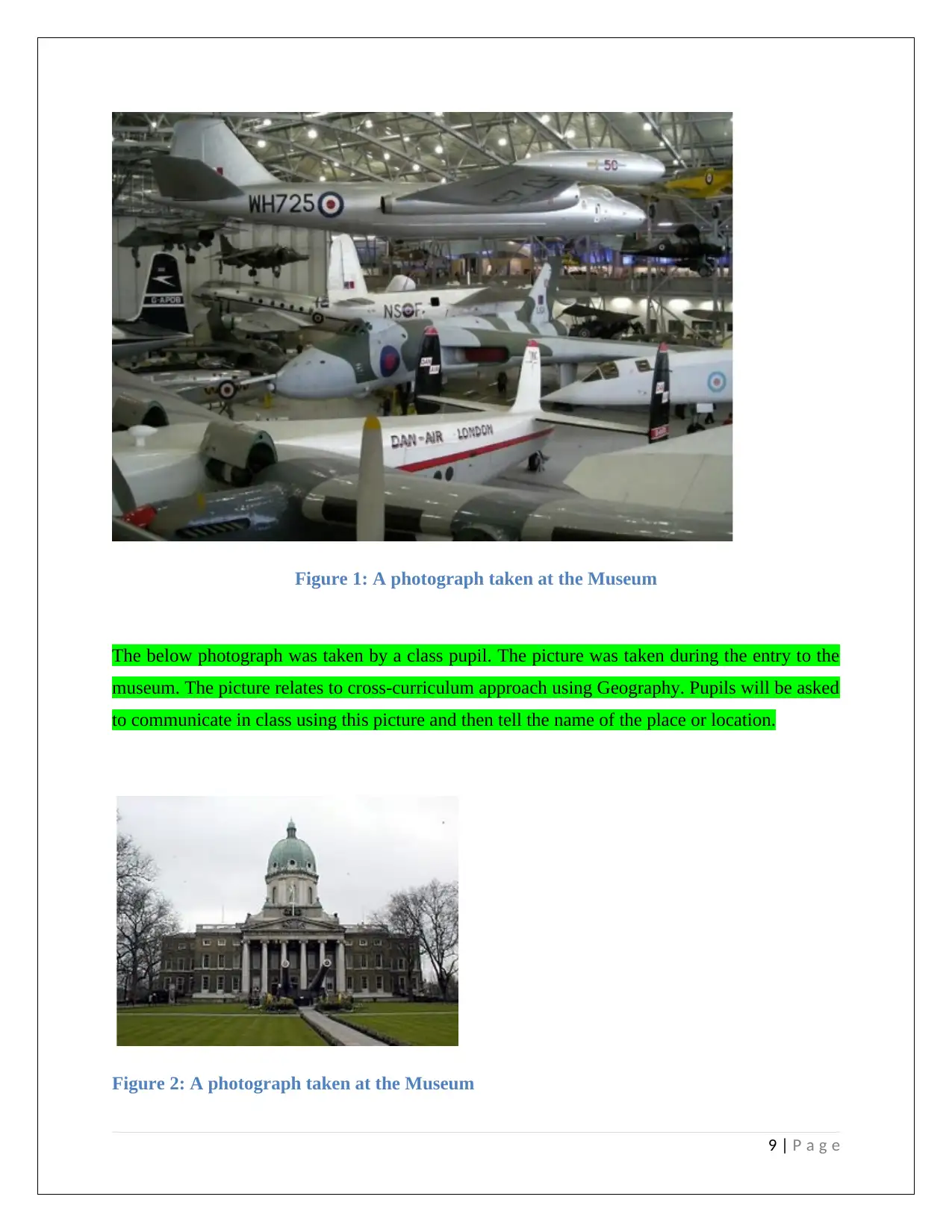
Figure 1: A photograph taken at the Museum
The below photograph was taken by a class pupil. The picture was taken during the entry to the
museum. The picture relates to cross-curriculum approach using Geography. Pupils will be asked
to communicate in class using this picture and then tell the name of the place or location.
Figure 2: A photograph taken at the Museum
9 | P a g e
The below photograph was taken by a class pupil. The picture was taken during the entry to the
museum. The picture relates to cross-curriculum approach using Geography. Pupils will be asked
to communicate in class using this picture and then tell the name of the place or location.
Figure 2: A photograph taken at the Museum
9 | P a g e
⊘ This is a preview!⊘
Do you want full access?
Subscribe today to unlock all pages.

Trusted by 1+ million students worldwide
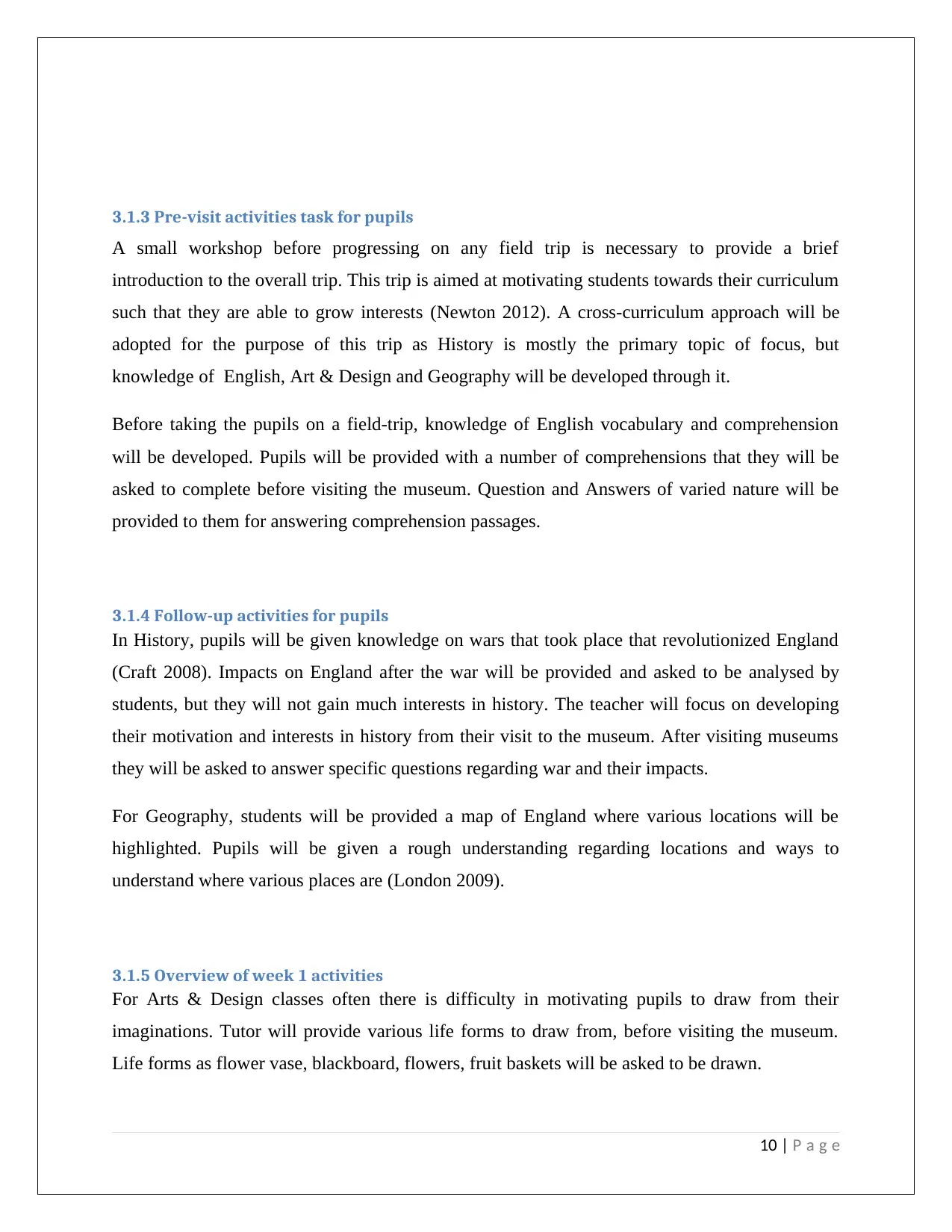
3.1.3 Pre-visit activities task for pupils
A small workshop before progressing on any field trip is necessary to provide a brief
introduction to the overall trip. This trip is aimed at motivating students towards their curriculum
such that they are able to grow interests (Newton 2012). A cross-curriculum approach will be
adopted for the purpose of this trip as History is mostly the primary topic of focus, but
knowledge of English, Art & Design and Geography will be developed through it.
Before taking the pupils on a field-trip, knowledge of English vocabulary and comprehension
will be developed. Pupils will be provided with a number of comprehensions that they will be
asked to complete before visiting the museum. Question and Answers of varied nature will be
provided to them for answering comprehension passages.
3.1.4 Follow-up activities for pupils
In History, pupils will be given knowledge on wars that took place that revolutionized England
(Craft 2008). Impacts on England after the war will be provided and asked to be analysed by
students, but they will not gain much interests in history. The teacher will focus on developing
their motivation and interests in history from their visit to the museum. After visiting museums
they will be asked to answer specific questions regarding war and their impacts.
For Geography, students will be provided a map of England where various locations will be
highlighted. Pupils will be given a rough understanding regarding locations and ways to
understand where various places are (London 2009).
3.1.5 Overview of week 1 activities
For Arts & Design classes often there is difficulty in motivating pupils to draw from their
imaginations. Tutor will provide various life forms to draw from, before visiting the museum.
Life forms as flower vase, blackboard, flowers, fruit baskets will be asked to be drawn.
10 | P a g e
A small workshop before progressing on any field trip is necessary to provide a brief
introduction to the overall trip. This trip is aimed at motivating students towards their curriculum
such that they are able to grow interests (Newton 2012). A cross-curriculum approach will be
adopted for the purpose of this trip as History is mostly the primary topic of focus, but
knowledge of English, Art & Design and Geography will be developed through it.
Before taking the pupils on a field-trip, knowledge of English vocabulary and comprehension
will be developed. Pupils will be provided with a number of comprehensions that they will be
asked to complete before visiting the museum. Question and Answers of varied nature will be
provided to them for answering comprehension passages.
3.1.4 Follow-up activities for pupils
In History, pupils will be given knowledge on wars that took place that revolutionized England
(Craft 2008). Impacts on England after the war will be provided and asked to be analysed by
students, but they will not gain much interests in history. The teacher will focus on developing
their motivation and interests in history from their visit to the museum. After visiting museums
they will be asked to answer specific questions regarding war and their impacts.
For Geography, students will be provided a map of England where various locations will be
highlighted. Pupils will be given a rough understanding regarding locations and ways to
understand where various places are (London 2009).
3.1.5 Overview of week 1 activities
For Arts & Design classes often there is difficulty in motivating pupils to draw from their
imaginations. Tutor will provide various life forms to draw from, before visiting the museum.
Life forms as flower vase, blackboard, flowers, fruit baskets will be asked to be drawn.
10 | P a g e
Paraphrase This Document
Need a fresh take? Get an instant paraphrase of this document with our AI Paraphraser

3.1.6 Overview of the visit
The visit will be highly interesting for pupils as they will be engaged across multiple activities.
Before the visit, at the time of the visit and post retuning from the visit, they will be engaged in
various recall activities. Pupils will be visiting the museum for the first time, hence they will be
motivated and feel highly interested in these activities.
3.2 Week 2 Activities
3.2.1 Overview of week 2 activities
The day of the field trip is crucial as students will be provided with a magnitude of information.
All those information in one day can be difficult to assimilate all at once, hence pupils will be
highly encouraged to take down notes in their copies that is for the field trip. While the teacher
will be taking the pupils slowly through various parts of the museum, they will allowed to halt at
places, take notes, pictures and other details they want to take. They might even want to take
photographs of draw certain pictures they like (Glauert 2013). Teachers will ask specifically
students to focus on various materials from war that have been kept at the museum to take notes
regarding them. Back at school students will be provided with flashcards of pictures of those
items, from where they need to do vocabulary practice.
3.2.2 Write activities and resources needed
The museum will provide large number of items from which students can learn new words as
aero-plane, bi-cycle, automobile and many more discoveries that took place during the World
War. The below photograph was taken by a class pupil. The picture gained his attention as he
liked airplanes, the picture captivated his interests. The picture relates to cross-curriculum
approach using history.
11 | P a g e
The visit will be highly interesting for pupils as they will be engaged across multiple activities.
Before the visit, at the time of the visit and post retuning from the visit, they will be engaged in
various recall activities. Pupils will be visiting the museum for the first time, hence they will be
motivated and feel highly interested in these activities.
3.2 Week 2 Activities
3.2.1 Overview of week 2 activities
The day of the field trip is crucial as students will be provided with a magnitude of information.
All those information in one day can be difficult to assimilate all at once, hence pupils will be
highly encouraged to take down notes in their copies that is for the field trip. While the teacher
will be taking the pupils slowly through various parts of the museum, they will allowed to halt at
places, take notes, pictures and other details they want to take. They might even want to take
photographs of draw certain pictures they like (Glauert 2013). Teachers will ask specifically
students to focus on various materials from war that have been kept at the museum to take notes
regarding them. Back at school students will be provided with flashcards of pictures of those
items, from where they need to do vocabulary practice.
3.2.2 Write activities and resources needed
The museum will provide large number of items from which students can learn new words as
aero-plane, bi-cycle, automobile and many more discoveries that took place during the World
War. The below photograph was taken by a class pupil. The picture gained his attention as he
liked airplanes, the picture captivated his interests. The picture relates to cross-curriculum
approach using history.
11 | P a g e

Figure 3: A photograph taken at the Museum
3.2.3 Preparation of the visit
Like the above pictures, other pictures and flashcards will be given to pupils for them to learn
new words or vocabulary. Collections at the Imperial War Museum Duxford is immense,
specially there is a section for aircrafts. There are documents, arts, sculptures, paintings, films,
exhibits and sound. Pupils can be also shown films from where they can pick up new vocabulary
that teacher can make flashcards back at school. For each vocab, pupils will be asked to connect
to core theme of the visit, which is World War II. The below photograph was taken by the
teacher. The picture can be used as a flash card in class activity. The picture relates to cross-
curriculum approach using English.
3.2.4 Post-visit activities task for pupils
Pupils will be engaged in post-visit activities task for the week 2 as well. They will not only
recall but also reproduce some of their learning’s from activities.
3.2.5 On-site activities task for pupils
During on-site activities for pupils, they will be shown various art forms and sculptures,
thereafter they can be asked questions from there.
12 | P a g e
3.2.3 Preparation of the visit
Like the above pictures, other pictures and flashcards will be given to pupils for them to learn
new words or vocabulary. Collections at the Imperial War Museum Duxford is immense,
specially there is a section for aircrafts. There are documents, arts, sculptures, paintings, films,
exhibits and sound. Pupils can be also shown films from where they can pick up new vocabulary
that teacher can make flashcards back at school. For each vocab, pupils will be asked to connect
to core theme of the visit, which is World War II. The below photograph was taken by the
teacher. The picture can be used as a flash card in class activity. The picture relates to cross-
curriculum approach using English.
3.2.4 Post-visit activities task for pupils
Pupils will be engaged in post-visit activities task for the week 2 as well. They will not only
recall but also reproduce some of their learning’s from activities.
3.2.5 On-site activities task for pupils
During on-site activities for pupils, they will be shown various art forms and sculptures,
thereafter they can be asked questions from there.
12 | P a g e
⊘ This is a preview!⊘
Do you want full access?
Subscribe today to unlock all pages.

Trusted by 1+ million students worldwide
1 out of 19
Related Documents
Your All-in-One AI-Powered Toolkit for Academic Success.
+13062052269
info@desklib.com
Available 24*7 on WhatsApp / Email
![[object Object]](/_next/static/media/star-bottom.7253800d.svg)
Unlock your academic potential
Copyright © 2020–2025 A2Z Services. All Rights Reserved. Developed and managed by ZUCOL.



